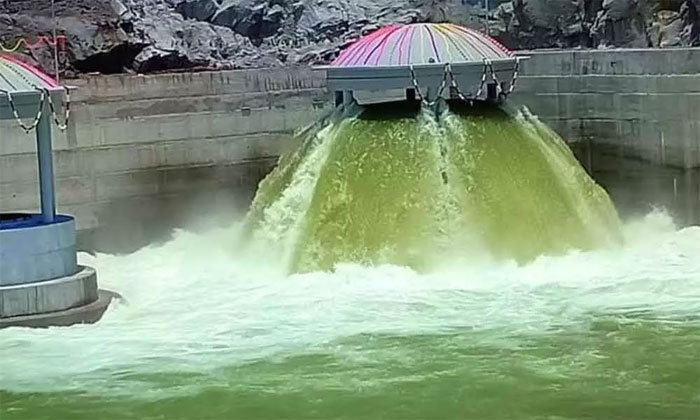The Telangana Government has created an engineering marvel of the first order that made it possible for the massive Godavari river to flow against the gravity. This engineering miracle has enabled the river to travel 300 meters up through a network of motorized lifts. What more, the water flow up is considerably faster than bigger projects like Handri Neeva, Colarado and Great Manmade River.
This is Kaleswhara Lift Irrigation Project, which has carved a niche for itself in the world irrigation history. Behind this engineering marvel is the quiet but the intense work put in by the Megha Engineering Infrastructure Limited. The fact that the MEIL has successfully put in place an electro-mechanical system complete complicated and complex technical and electrical intricacies of never-before proportions in just three years is in itself an epic effort.
Irrigation projects eat up decades to get going. The projects like Nagarjua Sagar, Sriram Sagar, Telugu Ganga and the Srisailam Left Bank Canal were launched decades ago but have not reached fruition till now. Each of these projects has taken up more than two decades. But the Kaleshwaram project was accomplished in a matter of just three years and is already lifting water. Construction of the Lift Irrigation Project is very different from the conventional irrigation project. Kaleshwaram has several tunnels and underground pump-houses. Yet, it was completed in three years and MEIL played no mean part in this gargantuan task. MEIL could accomplish this only due to the sheer dint of its engineering expertise, untiring determination and above all, experience spanning three decades.

The project was technically inaugurated on June 21 this year by three CMs of the Godavari basin and water was lifted then from Medigadda Lakshmi Pumping House to prove the viability of the project. Later, the key works of Link 1 and Link 2 have been accomplished. The MEIL played a crucial role in lifting 25 TMC by over 300 meters into Mid-Maneru reservoir, located close to the Sircilla district headquarters. Compared to this, Handri Neeva lifts just 18 TMC throughout the year, while Pattiseema LIS lifts 100 tmc of Godavari water and pumps it into Krishna river. Significantly, both the projects were built by the MEIL. But, the Kaleshwaram has succeeded in filling the 25-TMC-capacity Mid Maneru to the brim in just 0 days. This is nothing short of a miracle. The unique feature of the project is it first stores the water in the reservoirs en route Kaleshwaram and then re-pump them out. This is a unique system never seen before. The water flow in Pattiseema LIS is purely on gravity basis, while in Handri Neeva is smaller but complicated. It has several Lifts covering considerable length. But the pumps are of lower capacity. The total lifting capacity is 40 TMC, but it has not reached its full capacity till now. It is yet to reach even 20 TMC pumping capacity. But let it be stated that the problems are due mainly to the government’s decisions and the water availability and not the technical or pumping issues. To add to it, the reservoirs under the project are also of a smaller capaicity.
But unlike these, the Kaleshwaram can pump up to 2 TMC per day and thus can pump up to 160 TMC a year. Even in the experimental stage, it has pumped 25 TMC during the last six months of its operationalisation (the actual working days are lesser than the six-month period.) Most of the project works, including Medigadda Lakshmi, Annaram Saraswati, Sundila Parvathi, Lakshmipur, Underground Gayatri Pump house, Link 1 and 2, were built by the MEIL. Let it also be placed on record that international organizations like the BHEL, Andreze, Xylum and others too have played their part in ensuring that there were no technical snags.
The Laxmi Pump- house , which is part of the project is of crucial importance as it lifts the water and enables it to flow against gravity. It has lifted 24.062 TMC between July 5 and December 6. Thus, this lifting has been achieved in 3157 hours, which by any standards, is a remarkable feat. For this, as many as 11 pumps were used. The three CMs had first inaugurated the sixth pump. This pump worked uninterrupted for 489 hours to lift 3.71 TMCs. Each pump is of 40 MW capacity and pumps up to 0.00762 TMC, equivalent to a village reservoir, in one hour. Though started in June, the project has come for full use only from November 11.
Similarly, the Saraswathi pump house has eight machines, each of 40 MW capacity, which are fully functional and have pumped 18.559 TM between July 22 and December 6 through 1781 hours of non-stop lifting. The figth machine worked continuously for 295 hours to lift 3.080 TMC. The Parvathi Pump House, the last one in Link 1, has pumped 15.404 TMCs into Sripadasagar Ellampalli reservoir by working non-stop for 1639 hours.
The Laxmipur Gayatri Pump House is the world’s biggest pump house of its kind. It is built 430 hours underground and has seven units, each with a capacity of 139 MW. Never before have such huge units have been used in the irrigation sector. MEIL and the BHEL have worked together to make this a reality in a record time. These seven machines have worked for 2601 hours and lifted 29.70 TMCs into mid-Maneru. Now, the tank is brimming with water. Each machine is lifting 3180 cusecs each to a height of 170 feet. The pumping capacity is more than the capacity of canals like Telugu Ganga, SLBC, KC Canal and Tungabhadra upper canal. Thus the MEIL has played a key role in turning the flow of the mighty Godavari due to which there is water aplenty in Godavari at a time when the river normally runs dry. It has breathed life back into the parched lands of North Telangana.













